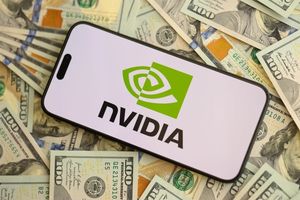
As of November 11, 2025, the U.S. financial markets are experiencing a significant period of volatility, largely driven by escalating concerns over a potential "AI bubble." After an AI-fueled rally propelled the Nasdaq Composite and S&P 500 to strong gains on Monday, November 10, Tuesday's trading saw a cautious retreat, with futures for both indices slipping. This seesaw action reflects a deeply divided analyst sentiment, where warnings of overstretched valuations for AI-related stocks clash with persistent long-term optimism for artificial intelligence's transformative power.
The immediate implications are a heightened sense of caution among investors, leading to profit-taking and a re-evaluation of high-flying tech stocks. While the long-term trajectory of AI remains promising, the market's current focus is on the sustainability of present valuations and the potential for a significant correction, especially given the substantial market concentration in a few dominant AI players.
AI Rally Cools Amidst Growing Valuation Concerns
The current market jitters come on the heels of a rollercoaster week for AI-related equities. On Monday, November 10, the market witnessed a robust AI-fueled rally, which, combined with optimism surrounding a potential resolution to the U.S. government shutdown, propelled major indices upwards. The Nasdaq Composite surged by 2.27%, marking its best single-day performance since May, while the S&P 500 climbed 1.54%, and the Dow Jones Industrial Average gained 0.81%. Leading the charge were key AI beneficiaries such as Nvidia (NASDAQ: NVDA), which jumped 5.8%, Alphabet (NASDAQ: GOOGL) with a 4% rise, and Microsoft (NASDAQ: MSFT), up 1.9%.
However, this exuberance was short-lived, as U.S. stock futures for the Nasdaq 100, S&P 500, and Dow Jones Industrial Average all slipped on Tuesday, November 11, trimming some of Monday's substantial gains. This immediate pullback underscores a broader trend of cooling in the AI rally over the preceding week. In the week ending November 7, the Nasdaq Composite experienced an approximate 3% decline, its steepest fall since mid-April. High-flying tech stocks deeply entrenched in AI saw even more significant drops, with Nvidia, for example, shedding 9.1% of its value during that week. Reports indicated that AI-focused stocks collectively lost over $800 billion in market value in the week prior to November 10, attributed to widespread profit-taking and investor fatigue over what many perceive as excessively high valuations.
A pivotal event contributing to the cautious sentiment on November 11 was the news of SoftBank Group Corp.'s (TYO: 9984) sale of its entire stake in Nvidia. This move by a major institutional investor reignited questions about the sustainability of valuations for leading AI beneficiaries. Earlier in November 2025, Nvidia had achieved a historic milestone, becoming the first publicly traded company to reach a staggering $5 trillion valuation, representing approximately 8% of the entire S&P 500 index. This concentration highlights the outsized influence a few AI giants now wield over the broader market, making any re-evaluation of their worth a significant event for all stakeholders.
AI's Impact: Winners, Losers, and Valuation Headwinds
The current climate of AI concerns presents a complex picture for public companies, creating both potential winners and losers while forcing a re-evaluation of business models and growth trajectories. Companies at the forefront of AI development and infrastructure, such as Nvidia (NASDAQ: NVDA), Alphabet (NASDAQ: GOOGL), and Microsoft (NASDAQ: MSFT), have been the primary beneficiaries of the AI boom, seeing their market capitalizations soar. Nvidia, in particular, has been a standout, reaching a $5 trillion valuation in early November 2025 due to its dominance in AI chip manufacturing. However, this success also places them at the epicenter of "AI bubble" concerns, making them highly susceptible to market corrections driven by profit-taking and valuation scrutiny. The recent 9.1% drop in Nvidia's stock in the week ending November 7, and SoftBank's decision to offload its entire stake, exemplify this vulnerability.
Other companies like Palantir Technologies (NYSE: PLTR), while positioned as a key player in AI-powered data analytics, have drawn criticism for extreme valuation metrics, such as trading at a 700x price-to-earnings (P/E) ratio in November 2025. Similarly, OpenAI, despite its groundbreaking ChatGPT, reported a substantial $13.5 billion loss against $4.3 billion in revenue in the first half of 2025, indicating a significant disconnect between its perceived value and current profitability. These examples highlight the precarious position of companies whose valuations are largely built on future potential rather than current financial performance, making them prime candidates for significant downside if investor sentiment shifts.
Conversely, companies with more diversified revenue streams or those that are "AI enablers" with demonstrated monetization capabilities may fare better. Microsoft (NASDAQ: MSFT), for instance, leverages AI through its Azure cloud services and Office 365, providing tangible revenue streams linked to AI adoption. Adobe (NASDAQ: ADBE) is another example, integrating AI into its creative suite to enhance existing products and services. For these companies, AI represents an enhancement to established businesses rather than the sole driver of their valuation, potentially offering a more stable investment in a volatile AI market. The broader market's focus will increasingly shift from speculative growth to companies that can demonstrate clear pathways to profitability and sustainable returns from their AI investments.
Broader Significance: Echoes of the Past and Future Implications
The current wave of AI concerns and market volatility carries broader significance, echoing historical precedents while shaping the future landscape of technology and finance. One of the most frequently drawn comparisons is to the dot-com bubble of 2000. While some analysts argue that current Nasdaq P/E ratios (around 32x) and AI stock valuations (ranging from 28x to 51x) are not yet as extreme as the over 70x P/E seen in March 2000, the rapid ascent and concentrated market capitalization in a few tech giants bear a striking resemblance. The tech sector, including AI-heavy firms, now accounts for approximately 36% of the S&P 500, a concentration level not seen since the dot-com era, amplifying the systemic risk should these high-flying stocks face a significant downturn.
The potential ripple effects extend beyond direct AI players to competitors and partners across various industries. Companies that have heavily invested in AI infrastructure or integrated AI solutions from leading providers could face indirect impacts if the AI sector experiences a correction. Supply chains reliant on AI chip manufacturers or software providers might see disruptions or re-evaluations. Furthermore, the intense focus on AI has diverted capital and attention from other innovative sectors, and a recalibration could lead to a broader reallocation of investment across the market.
Regulatory and policy implications are also beginning to emerge. Central banks and financial bodies, such as the Bank of England's Financial Policy Committee, have already cautioned that "equity market valuations appear stretched, particularly for technology companies focused on artificial intelligence." This kind of official warning signals a growing scrutiny from regulators, who might consider interventions or increased oversight if market instability persists or if concerns about "circular financing" and opaque investment structures within the AI industry gain traction. The August 2025 MIT report highlighting that 95% of corporate AI initiatives are yielding no returns, despite substantial investments, further underscores the need for transparency and accountability in AI investments, potentially leading to future disclosure requirements or investment guidelines.
What Comes Next: Navigating the AI Horizon
Looking ahead, the financial markets are poised for continued volatility as investors grapple with the trajectory of AI stocks and the broader economic environment. In the short term, the market will likely remain highly sensitive to news regarding AI company valuations, earnings reports, and any further institutional investor movements, such as the SoftBank stake sale. Profit-taking is expected to continue as investors seek to lock in gains from the rapid ascent of AI stocks, leading to potential price corrections and a more discerning approach to investment in the sector. The resolution of the U.S. government shutdown, while a separate issue, will also play a role in overall market sentiment, potentially providing a brief uplift or adding to uncertainty.
In the long term, the transformative potential of artificial intelligence remains undeniable, suggesting that the current period might represent a "healthy reset" rather than a complete collapse of the AI thesis. Companies will need to engage in strategic pivots and adaptations, shifting focus from pure speculative growth to demonstrating tangible returns on AI investments. This could involve prioritizing AI applications that offer clear productivity gains, cost efficiencies, or novel revenue streams. Market opportunities may emerge for companies that can effectively monetize AI, integrate it into core business functions, and present clear, sustainable growth models. Furthermore, a more mature AI market might foster innovation in less hyped, but equally impactful, areas of AI development.
Potential scenarios range from a continued, albeit slower, expansion of the AI sector, driven by genuine technological advancements and profitable applications, to a more significant market correction if the "AI bubble" fully deflates. Investors should prepare for a period where fundamental analysis, rather than speculative fervor, dictates stock performance. Companies with strong balance sheets, clear competitive advantages, and a disciplined approach to AI integration will be better positioned to weather potential storms and capitalize on the long-term opportunities that AI presents. The market will be watching for signs of sustainable earnings growth from AI initiatives, as well as any shifts in investor sentiment away from high-risk, high-reward bets towards more stable, value-driven investments.
A Crucial Juncture for the AI Market
The current market landscape, characterized by significant AI-driven volatility on November 11, 2025, represents a crucial juncture for the financial world. The key takeaway is the intense tension between the undeniable long-term promise of artificial intelligence and the immediate, pressing concerns over stretched valuations and a potential "AI bubble." While AI has demonstrated its capacity to revolutionize industries and drive unprecedented growth for companies like Nvidia (NASDAQ: NVDA), the speed and scale of this ascent have prompted caution from a growing chorus of financial experts, including prominent figures from J.P. Morgan (NYSE: JPM) and the Bank of England.
Moving forward, the market is poised for continued re-evaluation. Investors are increasingly scrutinizing underlying fundamentals rather than simply riding the wave of AI enthusiasm. The high concentration of market value in a few AI giants within indices like the S&P 500 means that their performance will continue to have a disproportionate impact on overall market health. This environment will likely favor companies that can clearly articulate and demonstrate how AI translates into sustainable profits and operational efficiencies, rather than relying solely on future potential.
The lasting impact of this period will likely be a more mature and discerning approach to AI investments. While the core technological advancements of AI will persist, the speculative froth may dissipate, leading to a healthier, albeit potentially slower, growth trajectory for the sector. Investors should watch closely for quarterly earnings reports from AI-centric companies, particularly focusing on revenue growth directly attributable to AI products and services, as well as any shifts in corporate strategies towards profitability. Furthermore, monitoring macroeconomic factors, interest rate policies, and any emerging regulatory discussions around AI will be critical in navigating the months ahead. The current volatility serves as a powerful reminder that even the most revolutionary technologies are not immune to the fundamental principles of market valuation.
This content is intended for informational purposes only and is not financial advice







